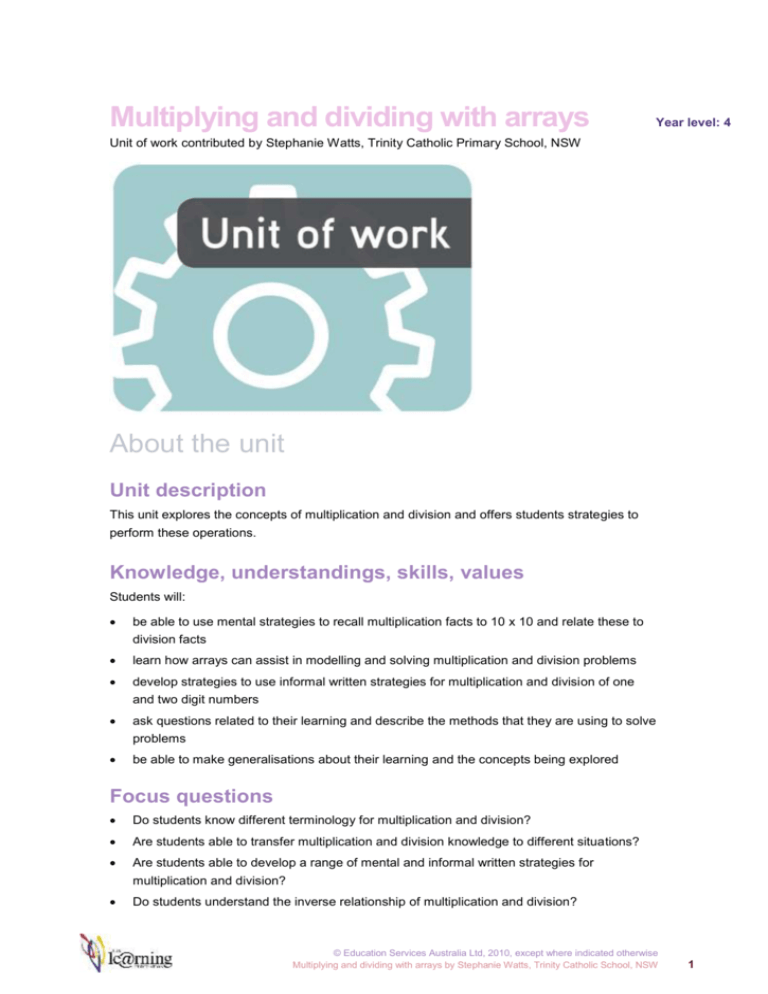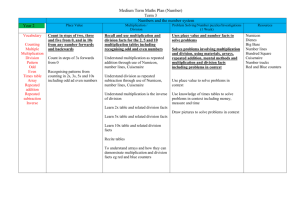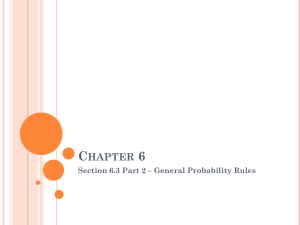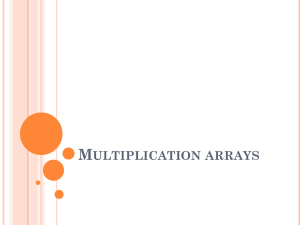uw_003_uniting_and_dividing
advertisement

Multiplying and dividing with arrays Year level: 4 Unit of work contributed by Stephanie Watts, Trinity Catholic Primary School, NSW About the unit Unit description This unit explores the concepts of multiplication and division and offers students strategies to perform these operations. Knowledge, understandings, skills, values Students will: be able to use mental strategies to recall multiplication facts to 10 x 10 and relate these to division facts learn how arrays can assist in modelling and solving multiplication and division problems develop strategies to use informal written strategies for multiplication and division of one and two digit numbers ask questions related to their learning and describe the methods that they are using to solve problems be able to make generalisations about their learning and the concepts being explored Focus questions Do students know different terminology for multiplication and division? Are students able to transfer multiplication and division knowledge to different situations? Are students able to develop a range of mental and informal written strategies for multiplication and division? Do students understand the inverse relationship of multiplication and division? © Education Services Australia Ltd, 2010, except where indicated otherwise Multiplying and dividing with arrays by Stephanie Watts, Trinity Catholic School, NSW 1 Resources Digital curriculum resources The array series: L106 The array, L108 The array: go figure, L2059 Arrays: factor families The multiplier series: L90 go figure, L83 generate easy multiplications Divide it up series: L2810 grouping tool, L2812 kittens, L2809 sharing tool Pobble arrays series: L2056 make multiples, L2058 find two factors Pobble arrays: assessment series: L9833 make multiples, L9832 find factors Other resources Multiplication grid A range of concrete materials such as counters, popsticks, Unifix cubes, MAB (multiattribute blocks) Calculators Egg cartons Dice Symbol cards for multiply and divide Butcher’s paper Fat felt-tip pens Attached printable resources The following teacher-created learning resources referred to in the unit of work are available for you to modify, print and use in your own teaching and learning context: Number cards 10 x 10 blank multiplication grid Matching the inverse activity Assessment task: The new school canteen Student reflection and feedback sheet © Education Services Australia Ltd, 2010, except where indicated otherwise Multiplying and dividing with arrays by Stephanie Watts, Trinity Catholic School, NSW 2 Teaching the unit Setting the scene Resources Fat felt-tip pens Butcher’s paper Teaching and learning activities Introduce students to the multiplication symbol and ask them where they have seen this symbol before. In small groups, have students write the ‘x’ symbol in the middle of a piece of butcher’s paper with a fat felt-tip pen. Surround this with all the other terms that the students know mean multiplication, such as ‘times’ or ‘repeated addition’. Discuss the various terms the students have written and create a master list. Repeat with the division symbol. Assessment Retain the group posters as evidence of students’ prior knowledge. Investigating Resources L106 The array L108 The array: go figure L90 The multiplier: go figure L83 The multiplier: generate easy multiplications A range of concrete materials Number cards (page 12) Dice Range of appropriate concrete materials 10 x 10 blank multiplication grid (page 11) Teaching and learning activities The Array Introduce students to L108 The array: go figure. As a class, work through the tutorial and ask students to identify what they notice about an array. Identify that an array shows a number in rows and columns. Have students work through L106 The array to find out the answer to a range of multiplication problems. © Education Services Australia Ltd, 2010, except where indicated otherwise Multiplying and dividing with arrays by Stephanie Watts, Trinity Catholic School, NSW 3 Provide students with a 10 x 10 grid (page 11) so they can record their ‘Finished facts’ as shown on screen. Use this to determine their understanding of using arrays. Laminate it to provide a ready reference for use in other situations. Creating arrays Teach the students to skip count. 1. Students stand in a circle. 2. Teacher picks a number and students count using multiples of that number from a given number (ie count by 5s from the number 20). 3. If a student says a number that is not a multiple, they are ‘out’ and must sit down. 4. The final student standing is the winner. 5. Alternatively, have students score a point for each correct response they give and the first to reach 10 (because they can keep track on their fingers) is the winner. As a class, explore forming arrays using concrete materials. What does 6 x 4 look like as an array? ~ Have students investigate and record the various options. Introduce ‘rows’ and ‘columns’. What other ways can we arrange these 24 items? Does 8 x 3 look the same as 3 x 8? ~ Have pairs create multiplication problems for partners to solve by creating arrays, using concrete materials. Record each combination. Challenge them to find the number (up to 10 x 10) that has the most combinations. Display some of the interesting arrays that the students create as a ‘Did you know’ poster, such as: ‘Did you know that 48 can be displayed as…’ Introduce the concept of ‘factors’. Using arrays Explore how arrays can be used as a written strategy to find out the answer to a multiplication problem. Explore multiplication arrays using one digit multiplied by one digit. Roll two dice or turn over two number cards. Create arrays using concrete materials or symbols. Record these and demonstrate the multiplication algorithm that accompanies them. More than 10 x 10 Set students a problem that is larger than 10 x 10 and observe and discuss the methods they use to solve it. Demonstrate split multiplication using L83 The multiplier: generate easy multiplications and then how to use the tools for L90 The multiplier: go figure. Have students work through this independently or with assistance, as required. © Education Services Australia Ltd, 2010, except where indicated otherwise Multiplying and dividing with arrays by Stephanie Watts, Trinity Catholic School, NSW 4 Demonstrate how to record the split method of multiplication to make arrays for larger combinations. 1. When multiplying larger numbers together, split the problem into multiplication algorithms you do know, eg 12 x 7 would become 10 x 7 + 2 x 7 = 70 + 14 = 84 2. 12 x 17 would become = (12 x 10) + (10 x 7) + 2 x 7 = 120 + 70 + 14 = 204 3. Draw the multiplication algorithms as arrays with addition symbols between them. Have students generate problems by rolling two dice of one colour and then one of another colour. Explore the options. If the rolled dice offer a 2, a 1, and a 6, how does the array for 12 x 6 differ from 21 x 6? ~ Extend the task by using four dice (two of two colours) and exploring the arrays and algorithms for all four numbers. For example a 4 + 5, and a 2 + 7 could be interpreted as: 45 x 27 54 x 27 45 x 72 54 x 72 How does using the array strategy assist your multiplication knowledge? ~ Have students keep their work in a portfolio so they can track their own development. Assessment Collect work samples for students’ portfolios to show their development. Have students record what each work sample demonstrates. Bringing it all together Resources Calculators L2059 Arrays: factor families Concrete materials Number cards (page 12) Matching the inverse activity (page 13) Divide it up series: L2810 grouping tool, L2812 kittens, L2809 sharing tool Pobble arrays series: L2056 make multiples, L2058 find two factors Pobble arrays: assessment series: L9833 make multiples, L9832 find factors © Education Services Australia Ltd, 2010, except where indicated otherwise Multiplying and dividing with arrays by Stephanie Watts, Trinity Catholic School, NSW 5 Teaching and learning activities Calculating problems Introduce calculators and demonstrate how to use these for multiplication. What do we need to know if we are going to use calculators for multiplication? ~ Demonstrate the need to have a mental estimate of the answer first to ensure the calculator is right. Give some students a calculator and then have a class challenge to see if using a calculator is always quicker. Separate students into multi-ability groups and ask them to answer a range of multiplication problems using either mental or written strategies or the calculator. Is the calculator always faster? ~ Discuss how effective each method was for the various types of problems. Everyday multiplication Discuss the use of multiplication in everyday life and create a class poster showing examples. Pose some word problems demonstrating everyday use such as: You have invited 15 guests to your birthday barbecue and each will eat 3 sausages. How many sausages will you need? You save $4 a week for a year. Do you have enough money for a collection of computer games that costs $200? ~ Help them analyse the problem by determining: What do you already know? What do you need to find out? What is the best method to work this out? ~ Have them record their responses in a format that shows their strategies. Encourage students to pose their own problems for their peers to investigate and answer. Making connections Explore and explain the quotient (or ‘how many’) aspect of division using both concrete and written examples such as: 5 students pool their money and discover they have $15 between them. Do they have enough for each to buy a $3 ice cream? You have 45 minutes to complete a sports rotation and you have to spend 5 minutes at each activity. How many activities can you complete in that time? © Education Services Australia Ltd, 2010, except where indicated otherwise Multiplying and dividing with arrays by Stephanie Watts, Trinity Catholic School, NSW 6 Explore the connection between multiplication and division. Explore words students know that mean division and place these on a poster. Use L2059 Arrays: factor families to explore the links between multiplication and division. What strategies did you use to answer the multiplication and division questions? How did you use your multiplication knowledge to answer division questions? Division array Investigate how arrays can be used to assist with division using the Pobble arrays learning objects. Demonstrate L2056 Pobble arrays: make multiples including how to record each example in written format. Have students work through L2058 Pobble arrays: find two factors independently. Assess their understanding by having them work through the two assessment objects and submit their printed version. Everyday division Pose the problem: Imagine you have the job of designing a chocolate box. There are to be 48 chocolates in the box. The box can be one or two layers high. How many ways could you arrange the chocolates in the box? ~ Model one way of arranging the chocolates in the box as 6 rows and 8 columns. Explain to students that these chocolates are arranged on one layer. Explore the multiplication and division facts modelled in this box, ie 6 x 8= 48, 8 x 6 = 48, 48 ÷ 6 = 8, 48 ÷ 8 = 6 Is this the only solution? ~ Students draw or make models of their solutions and discuss these in terms of multiplication and division facts and record solutions. Students share their solutions to the chocolate box problem and discuss the different ways people approached the problem and found solutions. Extend the activity to investigate how having two layers of chocolates would affect the solution. Retain solutions for their portfolios. Turning it around Students write a multiplication fact that they have trouble remembering, eg 8 x 7. They are encouraged to try mental strategies to help them recall that fact by using known facts, eg ‘I 49 which is 56’, or using the inverse relationship of division: ‘I k Is 56 ÷ 8 = 7 so 8 x 7 = 56 the only solution? © Education Services Australia Ltd, 2010, except where indicated otherwise Multiplying and dividing with arrays by Stephanie Watts, Trinity Catholic School, NSW 7 Students repeat the activity with a range of multiplication or division facts depending on their abilities. Encourage them to look for all the solutions. In pairs, students complete the Matching the inverse activity (page 13). Remind students that there might be more than one solution. Add a degree of difficulty by having them collect all versions of the same problem. How did you know which division problem matched a multiplication problem? What strategies did you use? Did you find any patterns? Building on Students are asked to write a multiplication and a division number fact and use these facts to build new number facts using successive doubling. Encourage the students to look for patterns. For example: 12 ÷ 3 = 4 24 ÷ 3 = 8 48 ÷ 3 = 16 96 ÷ 3 = 32 Discuss: What strategy did you use? What other strategies could you use? How did you use the relationship between multiplication and division facts? What patterns did you find? Divide it up Discuss with students situations where we use division in everyday life and record examples on butcher’s paper. Pose an everyday division question to students and model how to solve the problem using an array. Pose several more questions and ask individual students to solve them. Discuss the strategies that students used to solve the questions. Pose a question to students that includes remainders and explore how to solve it. For example: If there are 49 sweets in a packet, could a group of 6 students share them equally? You have $77 in your piggy bank. How many friends could you take to the movies if the tickets are $8 each? How much would you have to spend on popcorn? © Education Services Australia Ltd, 2010, except where indicated otherwise Multiplying and dividing with arrays by Stephanie Watts, Trinity Catholic School, NSW 8 Demonstrate how to record their answers. Have students use L2810 Divide it up: grouping tool to explore the concept and to consolidate their learning. When they have answered six division problems have them print their record sheet for their portfolios. Assessment Consolidate and assess their knowledge using L2812 Divide it up: kittens and L2809 Divide it up: sharing tool. Drawing conclusions Resources Poster paper Concrete materials Scrap paper for working out Assessment task: The new school canteen (pages 14 and 15) Student reflection and feedback sheet (page 16) Teaching and learning activities Problem solving Reflect on the previous session. Explain to students that they are going to write and solve division problems they face in their own everyday lives. Students are to record 3 division problems and solutions and then write 2 problems on poster paper for another student to solve. Exchange poster paper with other students and solve each other’s problems. What strategies did you use to solve the division problems posed by others? Did you use the same strategies each time? Did others use the same strategies as you did to solve the same problems? Do other students solve the same mathematical problems as you in everyday life? Assessment Students complete The new school canteen assessment task (pages 14 and 15) and then reflect on their learning using the reflection and feedback sheet. © Education Services Australia Ltd, 2010, except where indicated otherwise Multiplying and dividing with arrays by Stephanie Watts, Trinity Catholic School, NSW 9 Writer: Stephanie Watts The material in this unit of work may contain links to internet sites maintained by entities not connected to Education Services Australia Ltd and which it does not control (‘Sites’). Education Services Australia Ltd: provides the links for ease of reference only and it does not sponsor, sanction or approve of any material contained on the Sites; and does not make any warranties or representations as to, and will not be liable for, the accuracy or any other aspect of the material on the Sites or any other matter connected to the use of the Sites. While the material in this unit of work is not remunerable under Part VB of the Copyright Act 1968, material on the Sites may be remunerable under Part VB of the Copyright Act 1968. It is your responsibility to read and comply with any copyright information, notices or conditions of use which apply to a Site. © Education Services Australia Ltd, 2010, except where indicated otherwise Multiplying and dividing with arrays by Stephanie Watts, Trinity Catholic School, NSW 10 10 x 10 multiplication grid Name x Class 1 2 3 4 5 Date 6 7 8 9 10 1 2 3 4 5 6 7 8 9 10 © Education Services Australia Ltd, 2010, except where indicated otherwise Multiplying and dividing with arrays by Stephanie Watts, Trinity Catholic School, NSW 11 Number cards Name Class Date 1 2 3 4 5 6 7 8 9 © Education Services Australia Ltd, 2010, except where indicated otherwise Multiplying and dividing with arrays by Stephanie Watts, Trinity Catholic School, NSW 12 Matching the inverse Name Class Date Give students a copy of the multiplication playing board. Copy and cut out the division cards. Give students a set of division cards. The game may be played individually or as a team. Each player tries to be first to match the division card with the matching multiplication expression. Multiplication playing board Division cards set 1 Division cards set 2 82 93 43 16 2 27 3 12 3 16 8 27 9 12 4 83 72 22 24 3 14 2 4 2 24 8 14 7 42 73 63 11 3 21 3 18 3 33 3 21 7 18 6 33 11 10 2 53 32 20 2 15 3 62 20 10 15 5 63 10 3 33 12 12 2 18 2 63 12 6 18 9 62 12 2 42 13 22 2 10 2 36 3 22 11 10 5 36 12 62 92 23 30 3 93 22 30 10 93 21 11 2 52 12 3 24 2 82 33 24 12 84 31 © Education Services Australia Ltd, 2010, except where indicated otherwise Multiplying and dividing arrays by Stephanie Watts, Trinity Catholic School, NSW 13 The new school canteen Name Class Date Friday lunch order day!!! Trish in the canteen has asked for your assistance in helping her with lunch orders. Your task is to answer the following problems using your multiplication and division skills. In each box, draw an array and write the multiplication and division sentences that answer the problem. 1. Trish had 48 chicken nuggets in the freezer. All the nuggets were sold on Friday. How many students could have bought equal amounts of nuggets? How many nuggets did each student buy? 2. There were 24 packets of eucalyptus lollies in the canteen. Trish sold them all with no remainders. How many students bought equal amounts of eucalyptus lollies and how many packets did each student get? © Education Services Australia Ltd, 2010, except where indicated otherwise Multiplying and dividing with arrays by Stephanie Watts, Trinity Catholic School, NSW 14 3. There were 54 jelly babies left in the jar. All the jelly babies were sold. How many students bought equal amounts of jelly babies and how many did each student buy? Reflection question: what strategies did you use to solve the multiplication and division problems? © Education Services Australia Ltd, 2010, except where indicated otherwise Multiplying and dividing with arrays by Stephanie Watts, Trinity Catholic School, NSW 15 Student reflection and feedback sheet Name Class Date 1. What are three new things that you have learnt during this unit? 2. What challenged you during the unit? 3. Which activities did you enjoy the most and why? 4. Which activities did you learn the most from and why? 5. Which activities didn’t you feel assisted your learning and why? 6. What strategies would you use to teach someone the skills of multiplication and division? © Education Services Australia Ltd, 2010, except where indicated otherwise Multiplying and dividing with arrays by Stephanie Watts, Trinity Catholic School, NSW 16








